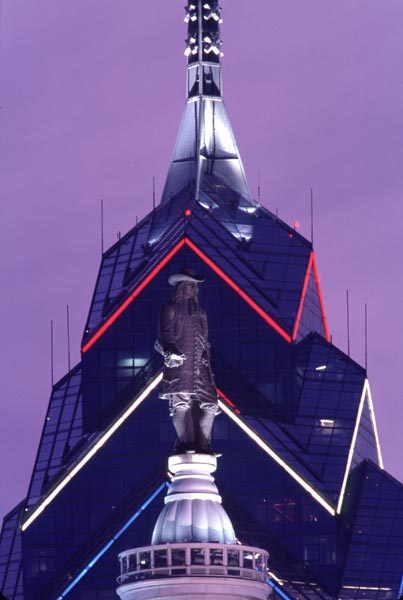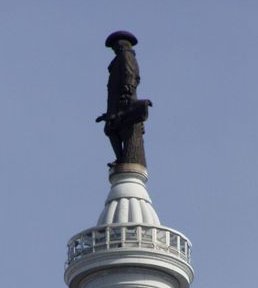Phinallie
« previous post | next post »
Yesterday afternoon, as I tried to stay warm on the sidelines of a junior-high soccer game, another father and I discussed the upcoming continuation of the fifth World Series game, suspended in a 2-2 tie by a downpour, two days earlier, after the top half of the sixth inning.
"Seems like they ought to win", I said, "with four at-bats versus three for the Rays."
The response: "You're not from here, are you?"
A couple of weeks ago, I mentioned the "lack of a sense of entitlement, not to say bitterness and cynicism, that's characteristic of Philly sports fans", and Tim McKenzie gave me a hard time for stereotyping a region. But that's how it is, here in Philadelphia.
Anyhow, the Phillies did win, and they only needed three turns at bat to do it. Here's a picture of the celebration on Broad Street that ran on the front page of the local newspaper site:
The Red Sox had to overcome the Curse of the Bambino to win in 2004. Now rumor has it in Philadelphia that there's a hidden statue on top of the Comcast Building, obviating the Curse of Billy Penn, "sometimes used to explain the failure of [the city's] professional sports teams … to win championships since the March 1987 construction of the One Liberty Place skyscraper, which exceeded the height of William Penn's statue atop Philadelphia City Hall":
Atop Philadelphia City Hall stands a statue of William Penn, the city founder and original proprietor of the then-British colony of Pennsylvania (meaning "Penn's Woods"). For many decades, a "gentlemen's agreement" stated that the Philadelphia Art Commission would approve no building in the city which would rise above this statue. This ended in March 1987, when a modern steel-and-glass skyscraper, One Liberty Place, opened three blocks away. One Liberty Place dwarfs City Hall by 397 feet (121m), rising 945 feet (288m) in height compared to the height of Penn's hat on city hall, 547ft 11-3/4in (167m). The measurement of the height of City Hall is usually rounded to 548 ft, which coincidentally matches the career number of home runs hit by Phillies Hall of Fame third baseman Mike Schmidt. Its sister skyscraper, Two Liberty Place, at 848 ft (258m), would soon follow.
Philadelphia sports teams had just before then enjoyed an enviable run of success: Major League Baseball's Philadelphia Phillies had won the 1980 World Series and the 1983 National League pennant; the National Hockey League's Philadelphia Flyers had won back-to-back Stanley Cups in 1974 and 1975, and were a regular presence in the finals (to wit, 1976, 1980, 1985, and 1987 as well as 1997); the National Football League's Philadelphia Eagles had appeared in Super Bowl XV, losing to the Oakland Raiders; and the National Basketball Association's Philadelphia 76ers had won the championship in 1983, as well as making the finals in 1977, 1980, 1982 and 2001.
The rumor is apparently true, though the new statue is only five inches high, rather than 37 feet:
 |
 |
Among baseball superstitions, the Curse of Billy Penn is slightly less silly than the Chicago Cub's Curse of the Billy Goat, since (as the Wikipedia article explains) Philadelphia's city hall was not only the tallest building in the city until 1987, but was actually the tallest building in the world from 1901 to 1908, and remains the world's tallest masonry building. But the shared word "Billy" does show a common cultural origin, and since the Billy Goat curse dates to 1945, while the Billy Penn curse dates only to the mid-nineties, we can be sure that Philadelphia was not the innovator in this case. On the other hand, the outcome of 2008 division series between the Cubs and the Dodgers suggests that the Billy Goat curse is still in effect.
Those who suspect a phallic subtext in all this concern over billies and building sizes will not be surprised to learn from the same article that "A joke among Philadelphians … is that when viewed from Ben Franklin Parkway the statue appears to be engaged in a lewd activity, due to the scroll in its hand", as imperfectly indicated in this photograph:

An alternative view might associate Billy Penn's curse with the traditional Quaker dislike of ostentation. As E. Digby Baltzell wrote in the 1995 introduction to a new edition of his 1979 classic Puritan Boston and Quaker Philadelphia,
The central theme of this book is that the elitist Puritan ethic firmly established class authority and deference democracy in Boston and Massachusetts and lasted from the colonial period down to the twentieth century; on the other hand, the egalitarian and victim ethic of Quakerism failed to produce class authority, resulting in the defiant democracy that has marked Philadelphia and Pennsylvania ever since. Two important unanticipated consequences flowed from these two antithetical ethics: In the first place, the hierarchical culture of Massachusetts produced great leaders on the local and national scene, while Philadelphia and Pennsylvania have produced hardly any leaders of distinction. This difference was nicely shown by a comparison of fifty First Families of Boston with fifty First Families of Philadelphia; while the Boston families produced 188 individuals with 34,365 liens written about them in the Dictionary of American Biography (DAB), the fifty leading families of Phildelphia produced only 146 individuals with 15,842 lines (or less than half) written about them in the DAB; twenty eight Boston Brahmins were memorialized by more than 300 line biographies while only three Proper Philadelphians were of such distinction.
After living here since 1990, my impression is that William Penn's legacy, whether seen as a curse or a blessing, has dissipated to a considerable extent.


Two observations « Rethorykal Questions said,
October 30, 2008 @ 9:20 am
[…] Language Log has a great entry, entitled, Phinally! Possibly related posts: (automatically generated)India tripPlease pay them more!Bajan journal: Our […]
Ken Grabach said,
October 30, 2008 @ 10:01 am
Interesting post. I watched the game from the top of the 8th inning when my wife and I returned from our library night stints. The television commentary gave a brief bit on the Billy Penn statue, and showed the small one at the stadium. Your 'billie' photo above seems if imperfect to display the salient features quite well.
I did not see the Phinallie banner displayed, but that is nice. One thing I like about Philadelphia fans is they seem not to overuse these types of homophonetic spellings. They are underdone just enough to make them more effective when used.
Nice to close with a picture of the Phanatic, which has always been my favorite of the costumed mascots that once were very popular at baseball clubs.
Michael W said,
October 30, 2008 @ 1:09 pm
I had a hard time with the title/banner – at first I didn't alter it from the start of "Phillie", and I still keep seeing it as "finale".
This is the first time I've heard "Billy" used for the state's founder, but I've never been near the area. Is "Billy Penn" common usage, or is it only used in connection with the curse?
William F Dowling said,
October 30, 2008 @ 3:08 pm
Use of "Billy Penn" in the context "Billy Penn's hat" is common, quite apart from the curse. I can't think of other contexts I've heard it in, though.
rpsms said,
October 30, 2008 @ 5:44 pm
Regarding cynicism: I have heard people characterize Philadelphia teams as having a high likelihood of "snatching defeat from the jaws of victory."
Scallionboy said,
October 31, 2008 @ 6:27 am
Reading the opening of this posting, up to "You're not from here, are you?" I was under the impression that the other father was commenting on your use of "four half-innings versus three for the Rays." the implication being that you were from, say, Luxembourg, or Mars. In decades of watching, listening to, reading and arguing about baseball I've never heard anyone use that construction.
The expression that lingers from my childhood, back when Mickey was in center for the Yanks, is that the Phillies had "last licks." Today broadcasters seems to favor "home-field advantage" or "three more outs" or "three more at-bats." I can't get my head around the idea of saying that one team has "an additional half-inning."
[(myl) Jeez, some days you just can't win. I originally wrote this with "at bats", and my baseball-loving lexicographer friend Ben Zimmer wrote to insist that at-bats can refer only to individual turns at the plate, and that the correct term is "half-inning". So I changed it, although (as I told Ben) the phrase sounded awkward and strange to me. Now I'm from Luxembourg, am I? Heck with it, I'm changing it back to "at bats".]
Scallionboy said,
October 31, 2008 @ 8:48 am
Oy. Your friend Zimmer is right. But you've still got it wrong, I'm afraid. "At bats" aren't the same as "half-innings."
The Phillies have, potentially, the same number of OUTS before they have to go into extra innings. But if the Phillies are leading after the top of the ninth, they wind up with three fewer OUTS, since they don't come out for the bottom of the inning.
"At bats" is misleading, since a team could easily have a dozen at-bats in a half inning. I still think "last licks" is the mot juste (mots justes?).
[(myl) But I didn't want to say that the Phillies would have last licks, I wanted to say that they as a team would have up to four turns as the team at bat (in the sixth, seventh, eighth and ninth innings), compared to only three for their opponents. I guess that I could have said that they'd get 12 outs to the Ray's 9, but that seems too… well, too something.]
K said,
October 31, 2008 @ 9:03 am
Umm…doesn't baseball have nine innings anymore? (I ask not because I'm too lazy to lookitup in Wikipedia, but on the theory that if I'm wondering about this, someone else is, too. So it's altruism, not laziness. Thanks.)
Ralph Hickok said,
October 31, 2008 @ 9:42 am
I also see "finale." But I suppose it's meant to be read as "finally"?
ajay said,
October 31, 2008 @ 11:05 am
There's a similar statue (possibly of Vitus Bering? Some explorer, anyway) in St Petersburg, also with interestingly positioned scroll. A rolled up map in his case.
Rob Perez said,
October 31, 2008 @ 6:27 pm
I'd say Scallionboy is the confused one. In this case, the Phils had an additonal half-inning. Bottom 6, plus 7-9 while the Rays only had 7-9. Because of the delay they had the unusual situation of getting both first and last licks. Last licks doesn't convey the entire situation. An extra half-inning does.
There are 118 ghits for ("extra half-inning" phillies) at the moment. Most of which seem to refer to Wednesday's game. Makes perfect sense to me.
Martyn Cornell said,
November 3, 2008 @ 1:00 pm
… and Americans complain about cricket having opaque rules and strange expressions …